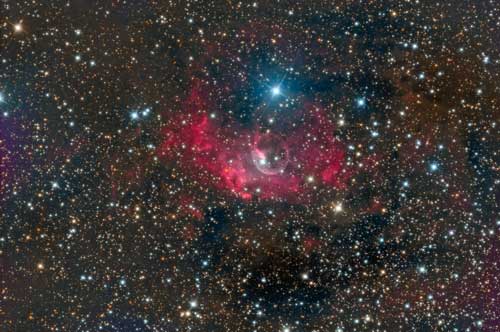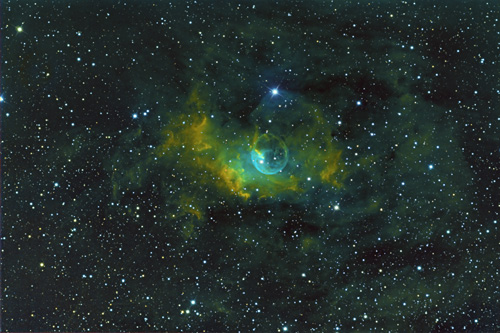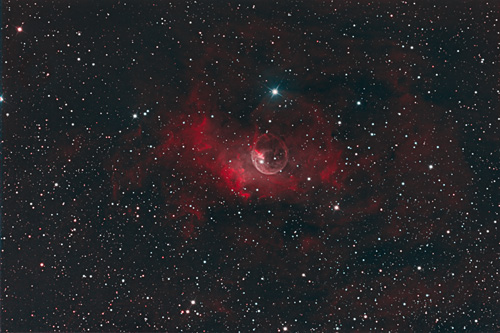|
| |
NGC7635
Image Information
Quoted From Wikipedia, the free encyclopedia:
NGC 7635, also known as the Bubble Nebula, Sharpless 162, or Caldwell 11, is an H II region[1] emission nebula in the constellation Cassiopeia. It lies close to the direction of the open cluster Messier 52. The "bubble" is created by the stellar wind from a massive hot, 8.7[1] magnitude young central star, SAO 20575 (BD+60°2522).[7] The nebula is near a giant molecular cloud which contains the expansion of the bubble nebula while itself being excited by the hot central star, causing it to glow.[7] It was discovered in 1787 by William Herschel.[5] The star BD+60°2522 is thought to have a mass of about 44 M☉.
Amateur observation
With an 8 or 10-inch (250 mm) telescope, the nebula is visible as an extremely faint and large shell around the star.[6][1] The nearby 7th magnitude star on the west hinders observation, but one can view the nebula using averted vision.[6] Using a 16 to 18-inch (460 mm) scope, one can see that the faint nebula is irregular, being elongated in the north south direction.[6
|

NGC7635 LRGB
1600
2000
3000

NGC7635 Hubble Palette
1600 2000
3000

NGC7635 Bi-Color
1600 2000
3000

| This Narrowband Hubble Pelette image consists of 48 Ha, 36 SII, and 27 OIII images. All are 30 minutes each all taken at
-20°C at bin 1x1. All images used so far totals
55.5 hours for the Narrowband set. The LRGB consists of 62 luminance , 27 red, 16 green and 32 blue for a total of 34.25 hours so far. All data was
acquired using MaxImDl/CCD version 6.14 using ACP 8.1. Pix Insight version 1.8.8 and Photoshop CS4 was used for processing. Dithered guiding was on. |
Equipment and Location Information
| Date |
September 13, 2016 - December 29, 2020 |
| Location |
Dogwood Ridge Observatory |
| Optics |
Optical Guidance Systems 12.5" RC @f/9 |
| Mount |
Astro Physics AP1200GTO |
| Camera |
SBIG STL-11000M/FW10/ |
| Filters |
Baader LRGB
50.8mm/Baader Ha,SII, OIII 50.8mm Filters |
| Conditions |
Transparency good to moderate. |
|
